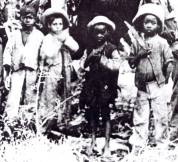

 |
AfroCubaWeb
|
 |
Click on the photos for full page versions. All photos © Gloria Rolando, 2001
 |
 |
| Four Mambises children | Mambises fighters |
 |
 |
| Mother & daughter mambisas | Mambi fighter cradling his rifle |
Click on each photo for a blow-up.
Photos of the Liberation Army ("Los Mambises") from
the film
Raíces de mi corazon by Gloria Rolando
The Mambi Army was the National Army of Liberation that defeated the Spanish through two wars: 1868 to 1878 and again, 1895 to 1898. Mambi is likely a Congo word. Recent estimates of the participation of Cubans of African descent in the Mambi Army run as high as 92%, but the more widely accepted figure in Cuba is 85%. This encounters resistance in Miami, where they prefer to think of the Mambi army as having a more important ibero spanish component.
Antonio Maceo, "the Bronze Titan," led the Mambi Army. His second in command was Quintín Bandera. In typical Congo fashion, their ritual roles were reversed: Bandera was the Tata Nkisi of the Mambi Army Nganga, the prenda or "magic cauldron" of the Mambises. And Antonio Maceo was the Mayordomo or Bakonfula of the prenda, which today is is said to still be a working prenda in Regla.
Invited by a Cuban plantocracy that was worried about the ascendancy of blacks, the Americans with Teddy Roosevelt intervened in 1898, routing a Spanish force that had already been defeated by the Mambi Army. And ironically enough, we now know that the 10th Cavalry, the Buffalo Soldiers, played a vital role in Teddy Roosevelt's adventure, providing the critical push that took San Juan Hill.
Links
orestesferrara.com/black_cuban_soldiers_mambi_1898_.htm
Independent Party of Color - Partido Independiente de Color
This first Black political party outside of Haiti was composed mostly of Mambi
veterans. Their massacre in 1912 is referred to as "El Doce".
www.afrocubaweb.com/photopages/independentsfoto.htm
www.afrocubaweb.com/history/eldoce.htm
[AfroCubaWeb] [Site Map] [Music] [Arts] [Authors] [News] [Search this site]